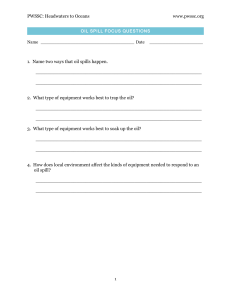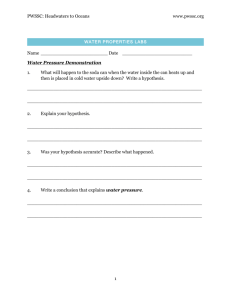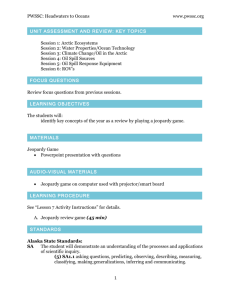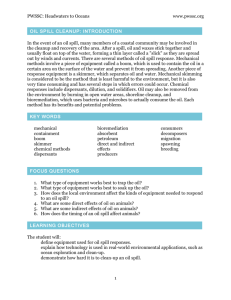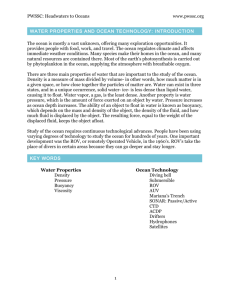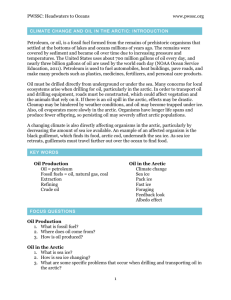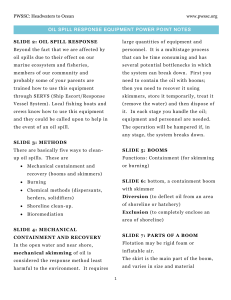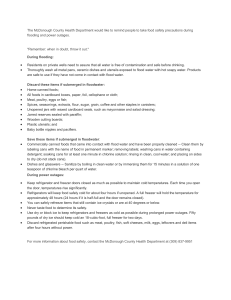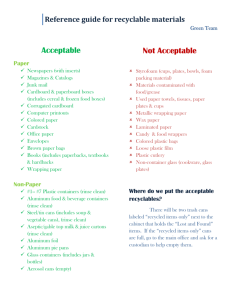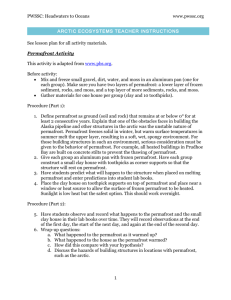H2O Lesson 2 Demo Instructions
advertisement
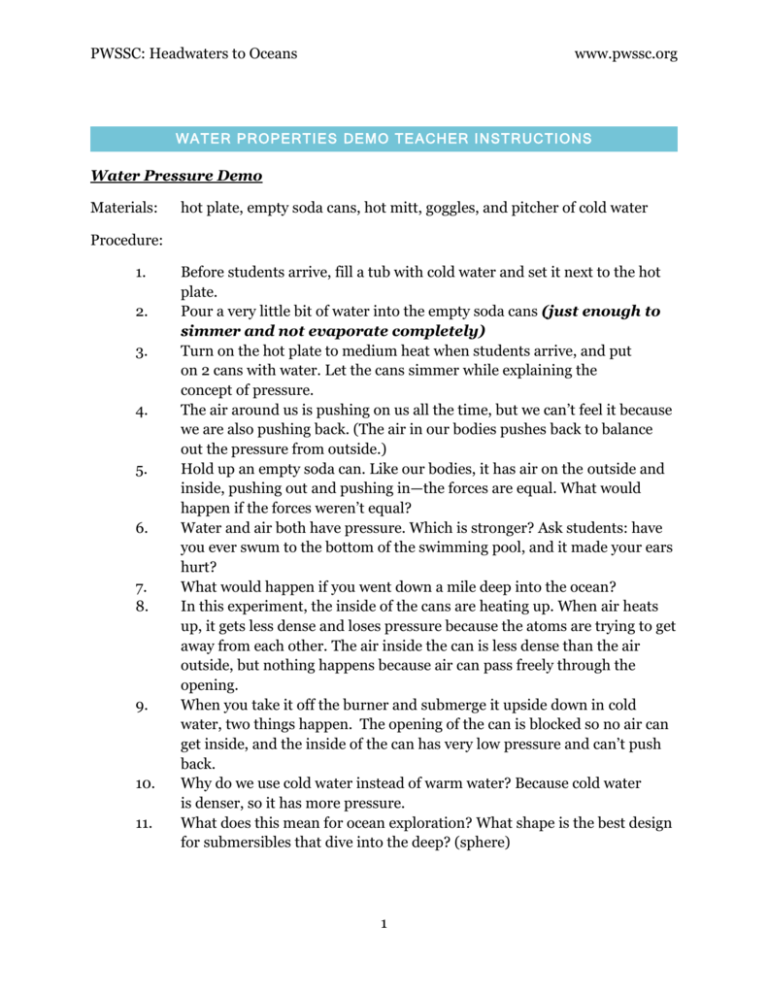
PWSSC: Headwaters to Oceans www.pwssc.org WATER PROPERTI ES DEMO TEACHER INSTRUCTIONS Water Pressure Demo Materials: hot plate, empty soda cans, hot mitt, goggles, and pitcher of cold water Procedure: 1. 2. 3. 4. 5. 6. 7. 8. 9. 10. 11. Before students arrive, fill a tub with cold water and set it next to the hot plate. Pour a very little bit of water into the empty soda cans (just enough to simmer and not evaporate completely) Turn on the hot plate to medium heat when students arrive, and put on 2 cans with water. Let the cans simmer while explaining the concept of pressure. The air around us is pushing on us all the time, but we can’t feel it because we are also pushing back. (The air in our bodies pushes back to balance out the pressure from outside.) Hold up an empty soda can. Like our bodies, it has air on the outside and inside, pushing out and pushing in—the forces are equal. What would happen if the forces weren’t equal? Water and air both have pressure. Which is stronger? Ask students: have you ever swum to the bottom of the swimming pool, and it made your ears hurt? What would happen if you went down a mile deep into the ocean? In this experiment, the inside of the cans are heating up. When air heats up, it gets less dense and loses pressure because the atoms are trying to get away from each other. The air inside the can is less dense than the air outside, but nothing happens because air can pass freely through the opening. When you take it off the burner and submerge it upside down in cold water, two things happen. The opening of the can is blocked so no air can get inside, and the inside of the can has very low pressure and can’t push back. Why do we use cold water instead of warm water? Because cold water is denser, so it has more pressure. What does this mean for ocean exploration? What shape is the best design for submersibles that dive into the deep? (sphere) 1 PWSSC: Headwaters to Oceans www.pwssc.org Elaboration: What would happen if you suddenly took away a lot of outside pressure? Have you ever gone up in an airplane and felt your ears pop? It feels like there’s air stuck inside them, because there’s more pressure inside than outside. Fish that live in the deep ocean are adapted to the pressure. Because they live with high external water pressure, their bodies have high internal pressure to push back. If we brought those fish up out of the deep ocean, the pressure inside their bodies wouldn’t have anything to balance against, and they would explode. Buoyancy Demo Materials: clear bucket of water, 3 objects with different states of buoyancy: positive (floats), negative (sinks), neutral (hovers). Procedure: Use examples to demonstrate and discuss buoyancy. Density Column Lab Materials: liquids of different densities, each with different color food coloring: water, rubbing alcohol, corn syrup, vegetable oil (do NOT add food coloring to vegetable oil) contained in small clear cups; 5 50 ml. graduated cylinder 1. Review with students the definition of density. 2. Divide the class of 25 into 5 groups of 4. 3. Tell students what the 4 colored liquids are: corn syrup, water, rubbing alcohol, and vegetable oil. Ask them to predict the order of density. (Remind them not to confuse density with viscosity. Viscosity is how thick something is, and is not related to density.) 4. Ask: how could you more accurately estimate which liquid is denser before pouring them, without just taking a wild guess? Density = mass / volume. 2 PWSSC: Headwaters to Oceans www.pwssc.org 5. Teacher pours equal amounts of each liquid into clear cups. Have students hold the cups in their hands and feel which is heavier. Since they are the same volume, the heavier ones will be denser. Note: make sure to ration the liquids so there’s enough for 5 groups of 4! 6. Have students make a hypothesis on the order of density, then pour the liquids into the graduated cylinder in the order of density, densest first. Elaboration: Why do we care about density? What happens when there’s an oil spill? Is oil more or less dense than water? What does that mean for cleaning it up? Oil floats on the surface of the water because it is less dense than water. This allows us to clean it up by skimming the oil from the water’s surface. How does density affect our ability to explore the ocean? Convection Demos Materials: convection tubes, hot and cold salt water, salt, food coloring Two Demos: one uses hot and cold water, one uses salty water and fresh water (Note: more obvious results with temperature if salt is also added to cold water.) Prodedure: 1. 2. 3. 4. 5. 6. Set up tubes. Have cold/blue/salty water and hot (not boiling)/red water ready. When ready to do the experiment, ask the students to hypothesize the results of the test. Fill the tubes with the red/hot water to JUST BELOW the upper cross tube. Fill the rest of the way with the cold/blue/salty water, and watch what happens. To empty, tip gently over a sink, watch out for spilling water. Elaboration: Can you think of any examples of places where different water temperatures meet? How would currents effect transportation of salinity and density? How would currents effect transportation of nutrients, fish, and food? 3
